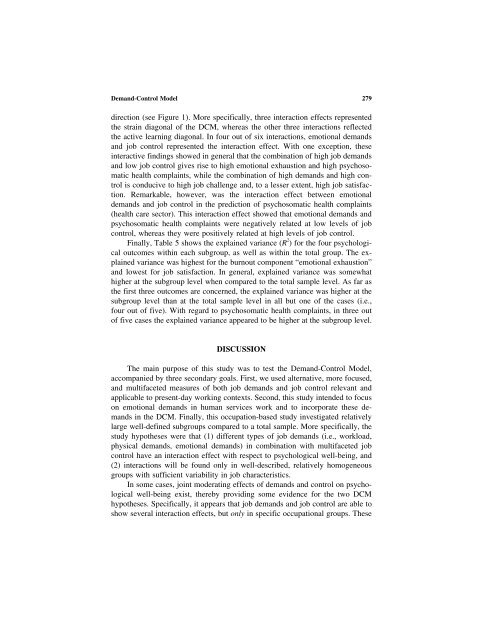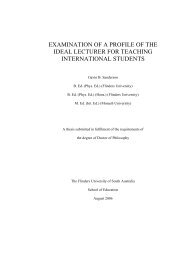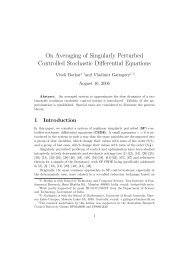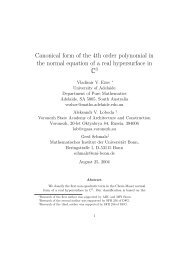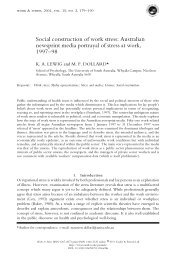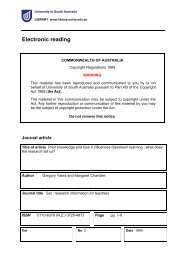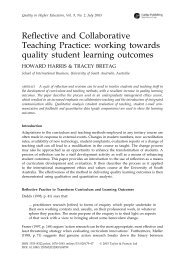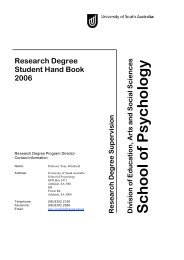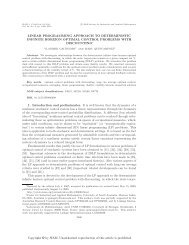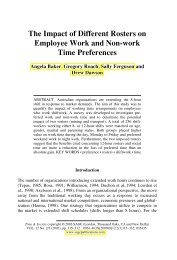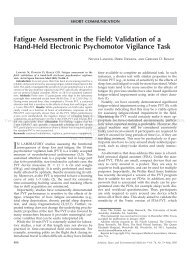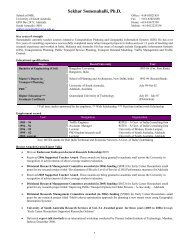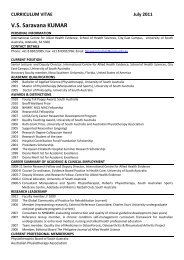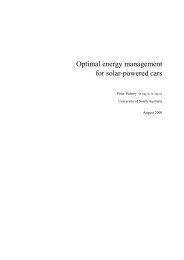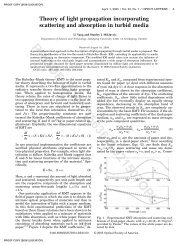The Demand-Control Model: Specific Demands ... - Study at UniSA
The Demand-Control Model: Specific Demands ... - Study at UniSA
The Demand-Control Model: Specific Demands ... - Study at UniSA
Create successful ePaper yourself
Turn your PDF publications into a flip-book with our unique Google optimized e-Paper software.
<strong>Demand</strong>-<strong>Control</strong> <strong>Model</strong>279direction (see Figure 1). More specifically, three interaction effects representedthe strain diagonal of the DCM, whereas the other three interactions reflectedthe active learning diagonal. In four out of six interactions, emotional demandsand job control represented the interaction effect. With one exception, theseinteractive findings showed in general th<strong>at</strong> the combin<strong>at</strong>ion of high job demandsand low job control gives rise to high emotional exhaustion and high psychosom<strong>at</strong>ichealth complaints, while the combin<strong>at</strong>ion of high demands and high controlis conducive to high job challenge and, to a lesser extent, high job s<strong>at</strong>isfaction.Remarkable, however, was the interaction effect between emotionaldemands and job control in the prediction of psychosom<strong>at</strong>ic health complaints(health care sector). This interaction effect showed th<strong>at</strong> emotional demands andpsychosom<strong>at</strong>ic health complaints were neg<strong>at</strong>ively rel<strong>at</strong>ed <strong>at</strong> low levels of jobcontrol, whereas they were positively rel<strong>at</strong>ed <strong>at</strong> high levels of job control.Finally, Table 5 shows the explained variance (R 2 ) for the four psychologicaloutcomes within each subgroup, as well as within the total group. <strong>The</strong> explainedvariance was highest for the burnout component “emotional exhaustion”and lowest for job s<strong>at</strong>isfaction. In general, explained variance was somewh<strong>at</strong>higher <strong>at</strong> the subgroup level when compared to the total sample level. As far asthe first three outcomes are concerned, the explained variance was higher <strong>at</strong> thesubgroup level than <strong>at</strong> the total sample level in all but one of the cases (i.e.,four out of five). With regard to psychosom<strong>at</strong>ic health complaints, in three outof five cases the explained variance appeared to be higher <strong>at</strong> the subgroup level.DISCUSSION<strong>The</strong> main purpose of this study was to test the <strong>Demand</strong>-<strong>Control</strong> <strong>Model</strong>,accompanied by three secondary goals. First, we used altern<strong>at</strong>ive, more focused,and multifaceted measures of both job demands and job control relevant andapplicable to present-day working contexts. Second, this study intended to focuson emotional demands in human services work and to incorpor<strong>at</strong>e these demandsin the DCM. Finally, this occup<strong>at</strong>ion-based study investig<strong>at</strong>ed rel<strong>at</strong>ivelylarge well-defined subgroups compared to a total sample. More specifically, thestudy hypotheses were th<strong>at</strong> (1) different types of job demands (i.e., workload,physical demands, emotional demands) in combin<strong>at</strong>ion with multifaceted jobcontrol have an interaction effect with respect to psychological well-being, and(2) interactions will be found only in well-described, rel<strong>at</strong>ively homogeneousgroups with sufficient variability in job characteristics.In some cases, joint moder<strong>at</strong>ing effects of demands and control on psychologicalwell-being exist, thereby providing some evidence for the two DCMhypotheses. <strong>Specific</strong>ally, it appears th<strong>at</strong> job demands and job control are able toshow several interaction effects, but only in specific occup<strong>at</strong>ional groups. <strong>The</strong>se


